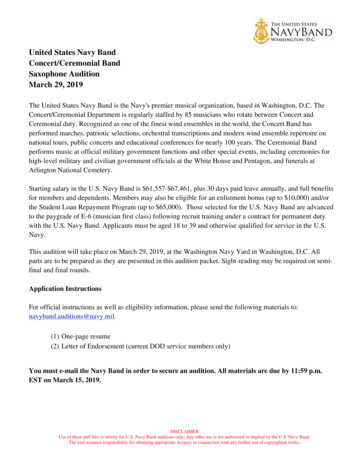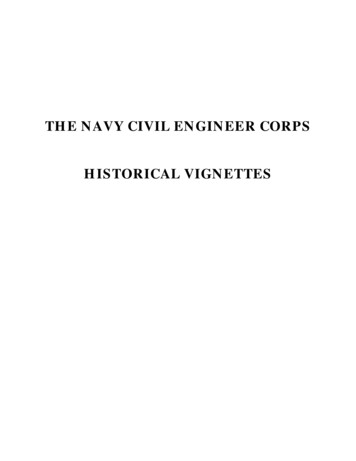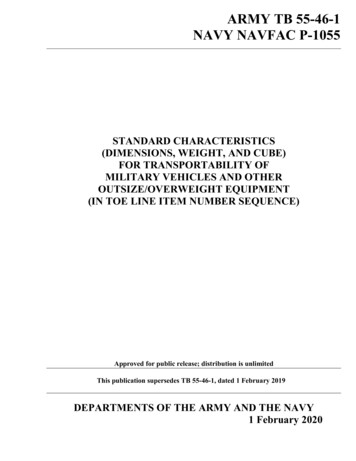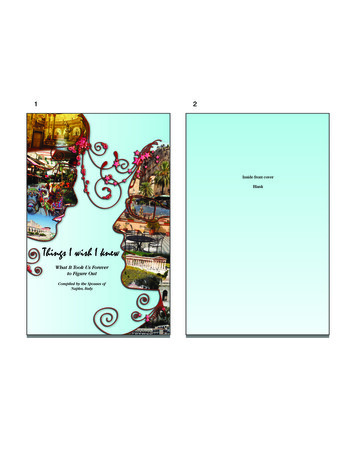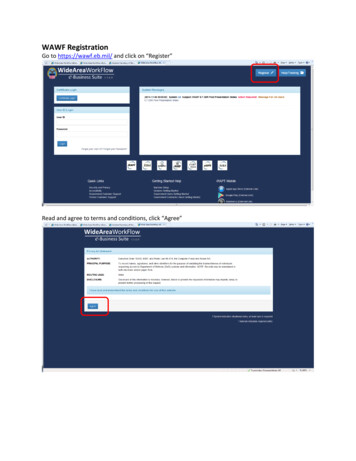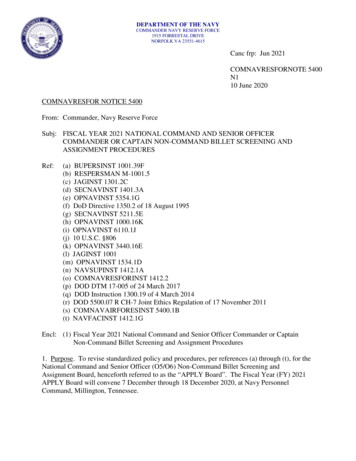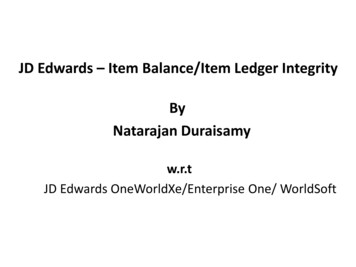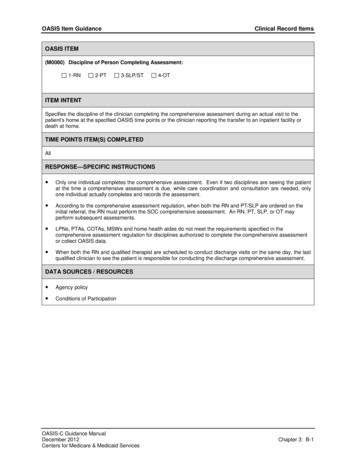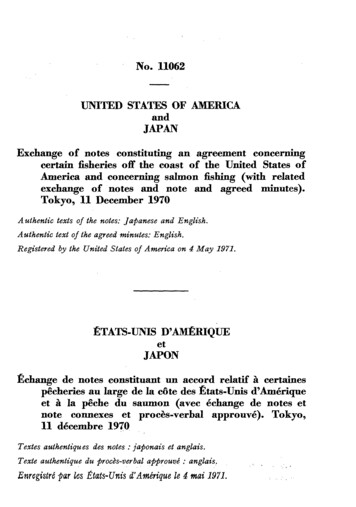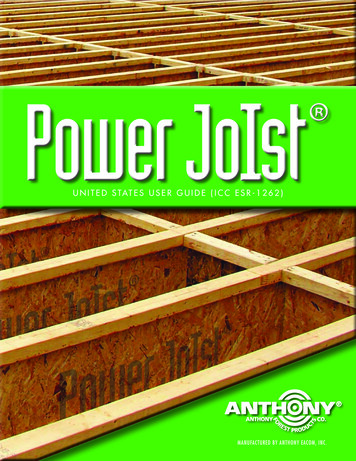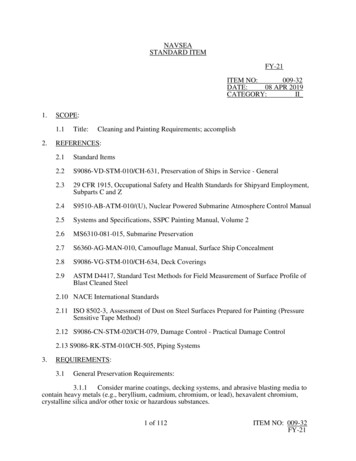
Transcription
NAVSEASTANDARD ITEMFY-21ITEM NO:009-32DATE:08 APR 2019CATEGORY:II1.SCOPE:1.12.Title:Cleaning and Painting Requirements; accomplishREFERENCES:2.1Standard Items2.2S9086-VD-STM-010/CH-631, Preservation of Ships in Service - General2.329 CFR 1915, Occupational Safety and Health Standards for Shipyard Employment,Subparts C and Z2.4S9510-AB-ATM-010/(U), Nuclear Powered Submarine Atmosphere Control Manual2.5Systems and Specifications, SSPC Painting Manual, Volume 22.6MS6310-081-015, Submarine Preservation2.7S6360-AG-MAN-010, Camouflage Manual, Surface Ship Concealment2.8S9086-VG-STM-010/CH-634, Deck Coverings2.9ASTM D4417, Standard Test Methods for Field Measurement of Surface Profile ofBlast Cleaned Steel2.10 NACE International Standards2.11 ISO 8502-3, Assessment of Dust on Steel Surfaces Prepared for Painting (PressureSensitive Tape Method)2.12 S9086-CN-STM-020/CH-079, Damage Control - Practical Damage Control2.13 S9086-RK-STM-010/CH-505, Piping Systems3.REQUIREMENTS:3.1General Preservation Requirements:3.1.1 Consider marine coatings, decking systems, and abrasive blasting media tocontain heavy metals (e.g., beryllium, cadmium, chromium, or lead), hexavalent chromium,crystalline silica and/or other toxic or hazardous substances.1 of 112ITEM NO: 009-32FY-21
3.1.2 Accomplish safety precautions as specified in 2.2, 2.3, and the Work Item ortask order during surface preparation and the application or removal of marine coatings.3.1.2.1Excluding underwater hull coatings that will contain heavymetals, plan for the removal of marine coatings that contains heavy metals up to the specifiedamount:Marine Coating Removal Per Ship ClassShip ClassSquare Foot of RemovalAircraft Carriers (CVN)Amphibious Assault Ships (LHD, LHA)Amphibious Command Ships (LCC)Guided Missile Cruisers (CG)Amphibious Transport Docks (LPD)Amphibious Dock Landing Ships (LSD)Guided Missile Destroyers (DDG)Submarines (SSGN, SSBN, SSN)Littoral Combat Ships (LCS)Mine Counter Measures Ships (MCM)Coastal Patrol Ships (PC)Repair and Berthing Barge (YRB, YRBM)20015015015010010010050505050503.1.2.2If the total costs are less than the cost to remove the authorizedsquare footage, remaining funds will be subject to recoupment. The contractor is not authorizedto exceed these limits.3.1.2.3For deck coverings installed onboard submarines, NAVSEAapproved deck covering systems must comply with the requirements of 2.4.3.1.3Blast Media:3.1.3.1Maintain a current copy of material certification of abrasive blastmedia conforming to MIL-A-22262, A-A-1722, A-A-59316, SSPC-AB 3, or SSPC-AB 4 forreference by the SUPERVISOR. Copy must be available prior to blasting. MIL-A-22262abrasives must be listed on the Qualified Products List (QPL), or the repair activity must havewritten notification from NAVSEA indicating pending listing on the QPL. Submit one legiblecopy, in hard copy or approved transferrable media, to the SUPERVISOR upon request. For AA-1722, A-A-59316, SSPC-AB 3, or SSPC-AB 4 abrasives, a complete data packagedemonstrating compliance with the requirements must be provided by the supplier to theprocuring activity. Exceptions are listed in 3.1.3.2 and 3.1.3.3.3.1.3.2Recyclable Encapsulated Abrasive Media material conforming toSSPC-AB 4 may be used as an alternative to obtain NACE 2/SSPC-SP 10 or SSPC-SP 11cleanliness.3.1.3.3Recyclable ferrous metallic abrasive materials conforming toSSPC-AB 3 of 2.5 may be used as an abrasive blast media for steel substrates. Cleanliness ofrecyclable ferrous metallic abrasive materials must be measured and maintained in accordancewith the requirements of SSPC-AB 2 of 2.5.3.1.3.4For requirements specified in 3.1.3.3, maintain a current copy ofthe results of the quality control requirements of Paragraph 6 of SSPC-AB 2 and quality2 of 112ITEM NO: 009-32FY-21
assurance test required by Paragraph 5 of SSPC-AB 3 of 2.5 for reference by the SUPERVISOR.Submit one legible copy, in hard copy or approved transferrable media, to the SUPERVISORupon request.3.1.3.5Steel media, defined as steel shot, steel grit, stainless steel media,and SSPC-AB 4 media containing steel abrasive MUST NOT be used for surface preparation onLHA, LHD, LPD, LSD and ESB Class ship flight deck, hangar, vertical replenishment deck,elevators, catwalk, and superstructure above the flight deck. Steel media may be used on tanksand voids below the flight, hangar, and vehicle storage decks and associated ramps withcontainment that prevents release of the steel media onto the flight deck, hangar, verticalreplenishment deck, elevators, catwalk, and superstructure above the flight deck. SSPC-AB 4media that does not contain steel abrasive or MIL-A-22262 abrasive may be used on flight decksand other areas of LHA, LHD, LPD, and LSD Class ships. The following checkpoints applyONLY when steel media is being used on an LHA, LHD, LPD, or LSD Class ship on tanks andvoids below the flight, hangar, and vehicle storage decks and associated ramps.(V)(G)”STEEL MEDIA BLASTING PROCESS AND MEDIA CONTAINMENTINSPECTION”3.1.3.6 Steel media may be used on tanks and voids below the flight, hangar,and vehicle storage decks and associated ramps with containment that prevents release of thesteel media onto the flight deck, hangar, vertical replenishment deck, elevators, catwalk, andsuperstructure above the flight deck.3.1.3.7Accomplish a start of blasting media containment inspection toensure blast media is contained within the confines of the work area. Any media detected outsideof the containment must be reported to the SUPERVISOR.(V)(G)”FINAL BLASTING MEDIA VISUAL INSPECTION”3.1.3.8 Accomplish a visual inspection to ensure all media, wastes from steelmedia blasting, and steel media blasting equipment is completely removed from the ship. Anymedia detected outside of the containment or left on the ship must be reported to theSUPERVISOR.3.1.4 Abrasive blast steel and aluminum plates, shapes, and ferrous piping, equalto NACE 2/SSPC-SP 10 of 2.5 and 2.10, establishing a surface profile that meets therequirements of 3.10.5, and coat, prior to shipboard installations except in the areas where weldjoints remain to be accomplished, or unless specified otherwise in the invoking Work Item ortask order. Material for fuel oil storage, fuel oil service, and diesel service tanks must not bepainted. If these materials are to be installed in potable water, reserve feedwater, or freshwaterdrain collection tanks, they must be blasted and coated at a maximum 50 percent relativehumidity from surface preparation checkpoint acceptance until cure to recoat time of final touchup of the topcoat; for materials to be installed in all other areas, they must be blasted and coatedat a maximum 85 percent relative humidity; this requirement supersedes Notes (26) and (29A).3.1.4.1For tanks, when masking is removed from the open ends ofpiping, the piping may retain tightly-adherent paint or remain bare up to 6 inches above the openend. Loose or delaminating paint must be prepared to SSPC-SP 2.3 of 112ITEM NO: 009-32FY-21
3.1.4.2For non-ferrous piping which penetrates bulkheads, extend paintone to 2 inches (onto the pipe) beyond the bulkhead penetration pipe-weld.3.1.4.3Non-ferrous piping and cable pans, which are to be preservedshipboard, must be prepared in accordance with SSPC-SP 2 or SSPC-SP 16 of 2.5. For paintednon-ferrous piping and cable pans in tanks of nuclear powered ships, surface preparation must bein accordance with SSPC-SP 16 of 2.5. The SSPC-SP 16 cleaning of non-ferrous piping may beaccomplished utilizing ferrous abrasive media. Non-ferrous piping one inch in diameter or lessmust not be prepared or painted; do not remove intact adherent coating from piping. Surfaceprofile is not required.3.1.4.4Diffusers in reserve feedwater dump tanks must not be painted.3.1.5 For steel substrates on surface ships, with the exception of potable water,reserve feedwater, and freshwater drain collecting tanks, nonskid system applications (MIL-PRF24667), and single coat applications (MIL-PRF-23236 Type VII Class x/18), preconstructionprimer may be retained and overcoated with applicable coating systems specified in Tables Onethrough 5, if the preconstruction primer application process meets the following:3.1.5.1The preconstruction primer must be a zinc silicate material.Compatibility with the coating systems specified in Tables One through 5 must be confirmed bythe coating manufacturer.3.1.5.2The preconstruction primer must be applied in a process which iscertified to ISO 9001, SSPC-QP 1, or SSPC-QP 3. The surface must meet the requirements ofNACE 2/SSPC-SP 10 of 2.5 and 2.10, and the process must be verified to meet the technicalrequirements of 3.10.2, 3.10.5, and 3.10.6 a minimum of once per shift.3.1.5.3The maximum relative humidity requirement of 3.10.1 must be85 percent.3.1.5.4The secondary surface preparation, once the steel is installedshipboard, must be accomplished in accordance with 3.1.5.5 through 3.1.5.8.3.1.5.5Accomplish degreasing/cleaning prior to surface preparation toensure that the surface is free of contaminants in accordance with SSPC-SP 1 of 2.5.3.1.5.6Brush-off blast clean the preconstruction primer-coated surface toNACE 4/SSPC-SP 7 of 2.5 and 2.10 to remove contaminants and loose paint. A thoroughpressure wash of the area with fresh water at 3,000 to 5,000 pounds per square inch (PSI) may besubstituted for the degreasing/cleaning to SSPC-SP 1 and the brush-off blast to NACE 4/SSPCSP 7. For cumulative surface areas less than 10 percent of the total area, with no individual areagreater than 10 square feet, an SSPC-SP 3 cleaning followed by a fresh water wipe may besubstituted for NACE 4/SSPC-SP 7.3.1.5.7For weld joints where the preconstruction primer was burnedaway, and for any other areas of visible rust where the preconstruction primer had beenpreviously damaged, clean the affected areas to the level required by applicable Line in TablesOne through 5.3.1.5.8Upon completion of secondary surface preparation, the surfacemust meet the requirements of SSPC-SP 1 of 2.5. A visual water break test (ASTM F-21 or F22) on the surface may be used to validate SSPC-SP 1.4 of 112ITEM NO: 009-32FY-21
3.1.6 For touch-up, disturbed (terms are clarified in 3.6), and/or inaccessible areas,the minimum surface preparation must be that shown in Tables One through 8, except that anSSPC-SP 11 is acceptable for areas originally requiring a NACE 2/SSPC-SP 10 or NACE/SSPCSP WJ-2. The decision that an area is inaccessible must be determined by inspection and agreedto by the SUPERVISOR prior to surface preparation. The degree of surface preparation requiredwould be the maximum possible for that area, but could include retention of existing tightlyadherent paint in inaccessible areas not to exceed 0.02 percent of the total surface area, with noindividual areas larger than 2 square inches.3.1.7 Excluding potable water and reserve feedwater tanks in submarines andaircraft carriers, freshwater drain collecting tanks in aircraft carriers, and the reactor auxiliaryroom bilges in aircraft carriers, feathering is not required in tanks, voids, machinery spaces, orbilges. Feathering is required on the underwater hull and other areas as directed by theSUPERVISOR. Feathering is explained in more detail in 3.6.4.3.1.8 Clean insulation and lagging prior to painting; ensure such areas are free offoreign matter and contaminants that would prevent adherence of paint.3.1.9 Clean and dry all prepared and previously coated surfaces; ensure suchsurfaces are free of foreign matter that will affect adherence of coatings. Inclusions such as dustand debris in the coating film must be removed prior to the application of the next coat.3.1.10 Record and restore existing painted labels, compartment designations, hullmarkings, interior photoluminescent tape/markings and other painted information which will beremoved or covered during cleaning and coating operations, except for Visual Landing Aid(VLA) markings. VLA marking installation is addressed in 3.11.13.3.1.11 Install masking material for protection of equipment and items not to becoated during preservation. Shipboard items not to be coated are listed in 2.2 and 2.6 andinclude bolted-crossbar aircraft securing fittings installed on aluminum flight decks. Removemasking material upon completion of final coating.3.1.12 Clean shoe coverings must be worn when walking on prepared or coatedsurfaces. Shoe coverings must be selected that do not degrade and contaminate surfaces.3.1.13 The requirements stated herein take precedence over all referenced documentsif there is a conflict.3.1.13.1 Unless otherwise specified herein, coatings listed on the QPLmust be applied. All coatings are to be applied in accordance with the manufacturer’sNAVSEA-reviewed ASTM F718 product data sheet. The requirements stated herein takeprecedence over the NAVSEA-reviewed ASTM F718 data sheets if there is a conflict. TheNAVSEA-reviewed ASTM F718 data sheets must supersede any other manufacturer’s ASTMF718 data sheets for that product, even if it is newer (more recent) than the NAVSEA-reviewedASTM F718 data sheets. Copies of the NAVSEA-reviewed ASTM F718 data sheets areavailable from the Naval Surface Treatment Center (NST Center) website:http://www.nstcenter.biz.3.1.14 Store coating system components in a cool, dry place. Do not expose tofreezing temperatures or direct sunlight. For all coatings, storage ambient temperature must bemaintained between 50 and 90 degrees Fahrenheit, or within the manufacturer’s recommendedstorage temperature range with written authorization from the SUPERVISOR. Low temperature5 of 112ITEM NO: 009-32FY-21
nonskid systems (nonskid and primer) must be stored between 65 and 85 degrees Fahrenheit withthe optimal storage temperature being between 70 and 80 degrees Fahrenheit.3.1.14.1 Monitor the storage temperature over the 24-hour period prior toinitiation of the application process and document the minimum and maximum temperatures
2.11 ISO 8502-3, Assessment of Dust on Steel Surfaces Prepared for Painting (Pressure Sensitive Tape Method) 2.12 S9086-CN-STM-020/CH-079, Damage Control - Practical Damage Control 2.13 S9086-RK-STM-010/CH-505, Piping Systems 3. REQUIREMENTS: 3.1 General Preservation Requirements: 3.1.1 Consider marine coatings, decking systems, and abrasive blasting media to contain heavy metals (e.g .
